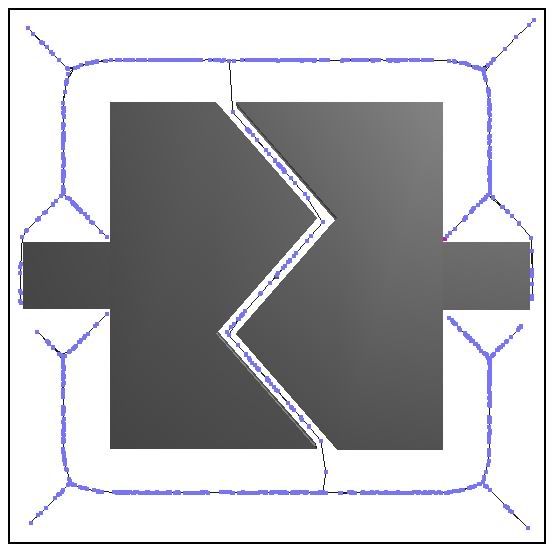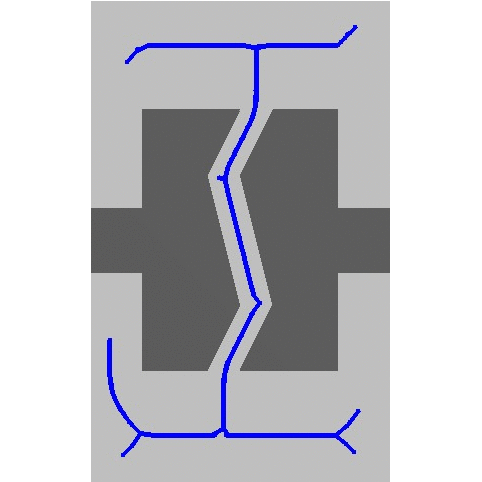Current motion planning research aims not ony to find feasible paths, but to ensure paths have certain properties, e.g., shortest or safest paths. The medial axis is the set of all points equidistant between two or more obstacle boundaries. For an n-dimensional space, the medial axis is an n-1-dimensional manifold which represents the connectivity of the space. Thus, the medial axis is a useful tool for computing high clearance motions and paths.
While a random sample will not lie on the medial axis, we have developed a strategy for efficiently generating points arbitrarily nearby the medial axis. We use the observation that any point, free or not, may be retracted to the medial axis by monitoring when the witness point (for collision) changes during the retraction. We use this function to apply medial axis retraction two two large classes of sampling based motion planning algorithms: PRMs and RRTs. We develop two sampling-based algorithms: MAPRM and MARRT and show their effectiveness in solving narrow passage problems and generating high clearance solutions. While these methods work well in practice, they do not provide any guarantees about the distribution of the points on the medial axis. We developed another strategy, Uniform Medial-Axis PRM, which is less efficient, but that uniformly samples the medial axis of the planning space.
MAPRM: Medial Axis PRM

A graph-based PRM Planner that samples the medial axis of the free C-Space
MARRT: Medial Axis RRT

An tree-based planner that samples the medial axis of C-Space
UMAPRM: Uniform MAPRM

A graph-based PRM planner that uniformly samples the medial-axis of the free C-Space.
Related Publications
MARRT: Medial Axis Biased Rapidly-Exploring Random Trees, Jory Denny, Evan Greco, Shawna L. Thomas, Nancy M. Amato, 2014 IEEE International Conference on Robotics and Automation (ICRA), pp. 90-97, Hong Kong, China, Jun 2014. DOI: 10.1109/ICRA.2014.6906594 @INPROCEEDINGS{6906594, author={J. {Denny} and E. {Greco} and S. {Thomas} and N. M. {Amato}}, booktitle={2014 IEEE International Conference on Robotics and Automation (ICRA)}, title={MARRT: Medial Axis biased rapidly-exploring random trees}, year={2014}, volume={}, number={}, pages={90-97}, doi={10.1109/ICRA.2014.6906594}} Motion planning is a difficult and widely studied problem in robotics. Current research aims not only to find feasible paths, but to ensure paths have certain properties, e.g., shortest or safest paths. This is difficult for current state-of-the-art sampling-based techniques as they typically focus on simply finding any path. Despite this difficulty, sampling-based techniques have shown great success in planning for a wide range of applications. Among such planners, Rapidly-Exploring Random Trees (RRTs) search the planning space by biasing exploration toward unexplored regions. This paper introduces a novel RRT variant, Medial Axis RRT (MARRT), which biases tree exploration to the medial axis of free space by pushing all configurations from expansion steps towards the medial axis. We prove that this biasing increases the tree's clearance from obstacles. Improving obstacle clearance is useful where path safety is important, e.g., path planning for robots performing tasks in close proximity to the elderly. Finally, we experimentally analyze MARRT, emphasizing its ability to effectively map difficult passages while increasing obstacle clearance, and compare it to contemporary RRT techniques.
Keywords: Motion Planning, Sampling-Based Motion Planning
Links : [Published] BibTex
Abstract
UMAPRM: Uniformly Sampling the Medial Axis, Hsin-Yi (Cindy) Yeh, Jory Denny, Aaron Lindsey, Shawna L. Thomas, Nancy M. Amato, 2014 IEEE International Conference on Robotics and Automation (ICRA), pp. 5798 -5803, Hong Kong, China, Jun 2014. DOI: 10.1109/ICRA.2014.6907711 @INPROCEEDINGS{6907711, author={H. C. {Yeh} and J. {Denny} and A. {Lindsey} and S. {Thomas} and N. M. {Amato}}, booktitle={2014 IEEE International Conference on Robotics and Automation (ICRA)}, title={UMAPRM: Uniformly sampling the medial axis}, year={2014}, volume={}, number={}, pages={5798-5803}, doi={10.1109/ICRA.2014.6907711}} Maintaining clearance, or distance from obstacles, is a vital component of successful motion planning algorithms. Maintaining high clearance often creates safer paths for robots. Contemporary sampling-based planning algorithms that utilize the medial axis, or the set of all points equidistant to two or more obstacles, produce higher clearance paths. However, they are biased heavily toward certain portions of the medial axis, sometimes ignoring parts critical to planning, e.g., specific types of narrow passages. We introduce Uniform Medial Axis Probabilistic RoadMap (UMAPRM), a novel planning variant that generates samples uniformly on the medial axis of the free portion of C space . We theoretically analyze the distribution generated by UMAPRM and show its uniformity. Our results show that UMAPRM's distribution of samples along the medial axis is not only uniform but also preferable to other medial axis samplers in certain planning problems. We demonstrate that UMAPRM has negligible computational overhead over other sampling techniques and can solve problems the others could not, e.g., a bug trap. Finally, we demonstrate UMAPRM successfully generates higher clearance paths in the examples.
Keywords: Motion Planning, Sampling-Based Motion Planning
Links : [Published] BibTex
Abstract
A general framework for sampling on the medial axis of the free space, Jyh-Ming Lien, Shawna L. Thomas, Nancy M. Amato, In Proc. IEEE Int. Conf. Robot. Autom. (ICRA), Vol: 3, pp. 4439-4444, Taipei, Taiwan, Sep 2003. DOI: 10.1109/ROBOT.2003.1242288 @INPROCEEDINGS{1242288, We propose a general framework for sampling the configuration space in which randomly generated configurations, free or not, are retracted onto the medial axis of the free space. Generalizing our previous work, this framework provides a template encompassing all possible retraction approaches. It also removes the requirement of exactly computing distance metrics thereby enabling application to more realistic high dimensional problems. In particular, our framework supports methods that retract a given configuration exactly or approximately onto the medial axis. As in our previous work, exact methods provide fast and accurate retraction in low (2 or 3) dimensional space. We also propose new approximate methods that can be applied to high dimensional problems, such as many DOF articulated robots. Theoretical and experimental results show improved performance on problems requiring traversal of narrow passages. We also study tradeoffs between accuracy and efficiency for different levels of approximation, and how the level of approximation effects the quality of the resulting roadmap.
Keywords: Medial Axis, Sampling-Based Motion Planning
Links : [Published] BibTex
author={ {Jyh-Ming Lien} and S. L. {Thomas} and N. M. {Amato}},
booktitle={2003 IEEE International Conference on Robotics and Automation (Cat. No.03CH37422)}, title={A general framework for sampling on the medial axis of the free space},
year={2003},
volume={3},
number={},
pages={4439-4444 vol.3},
doi={10.1109/ROBOT.2003.1242288}}Abstract
A Probabilistic Method for Rigid-Body Motion Planning Using Sampling from the Medial Axis of the Free Space, Steven A. Wilmarth, Doctoral Dissertation, Texas A&M University, pp. 1-108, Dec 1999. @phdthesis{wilmarth-phd-1999 Motion planning in the presence of obstacles is an important problem in robotics with numerous applications in other areas. While complete motion planning algorithms do exist, they are rarely used in practice since they are computationally infeasible in all but the simplest cases. For this reason, many recent efforts have focused on probabilistic methods, which sacrifice completeness in favor of computational feasibility and applicability. In particular, several algorithms, known as probabilistic roadmap planners, have been shown to perform well in a number of practical situations; however, their performance degrades when paths are required to pass through narrow passages in the free space. In this dissertation we present a method of sampling the configuration space of a rigid body moving in three dimensions in which randomly generated configurations are retracted onto the medial axis of the free space. We develop some theory of the medial axis on the configuration space SE(3) and present algorithms that perform the retraction while avoiding explicit computation of the medial axis. Finally, we give some preliminary experimental results demonstrating the performance of the algorithm.
Keywords: Computational Geometry, Medial Axis, Sampling-Based Motion Planning
Links : [Published] BibTex
, author = "Steven A. Wilmarth"
, title = "A Probabilistic Method for Rigid-Body Motion Planning Using Sampling from the Medial Axis of the Free Space"
, school = "Department of Mathematics, Texas A\&M University"
, year = "1999"
, month = "December"
}
Abstract
Motion planning for a rigid body using random networks on the medial axis of the free space, Steven A. Wilmarth, Nancy M. Amato, Peter F. Stiller, Proceedings of the Annual Symposium on Computational Geometry (SOCG), pp. 173-180, Jun 1999. DOI: 10.1145/304893.304967 @INPROCEEDINGS{was-mprb-99, Several motion planning methods using networks of randomly generated nodes in the free space have been shown
to perform well in a number of cases, however their performance
degrades when paths are required to pass through narrow
passages in the,jree space. In [16] we proposed MAPRM,
a method of sampling the configuration space in which randomly
generated configurations, free or not, are retracted
onto the medial axis of the free space without having to first
compute the medial axis; this was shown to increase sampling
in narrow passages. In this paper we give details of
the MAPRM algorithm for the case of a free-flying rigid
body moving in three dimensions, and show that the retraction
may be carried out without explicitly computing the C-obstacles
or the medial axis. We give theoretical arguments
to show that this improves sampling in narrow corridors, and
present preliminary experimental results comparing the performance
to uniform random sampling from the free space.
Keywords: Computational Geometry, Medial Axis, Sampling-Based Motion Planning
Links : [Published] BibTex
author={Steven A. Wilmarth and and Nancy M. Amato and Peter F. Stiller},
booktitle={Proceedings of the Annual Symposium on Computational Geometry}
title={Motion Planning for a Rigid Body Using Random Networks on the Medial Axis of the Free Space},
year={1999},
pages={173-180},
doi={10.1145/304893.304967}}Abstract
MAPRM: A Probabilistic Roadmap Planner with Sampling on the Medial Axis of the Free Space, S. A. Wilmarth, N. M. Amato, P. F. Stiller, Proceedings of IEEE International Conference on Robotics and Automation, pp. 1024-1031, Detroit, MI, May 1999. DOI: 10.1109/ROBOT.1999.772448 @INPROCEEDINGS{772448, Probabilistic roadmap planning methods have been shown to perform well in a number of practical situations, but their performance degrades when paths are required to pass through narrow passages in the free space. We propose a new method of sampling the configuration space in which randomly generated configurations, free or not, are retracted onto the medial axis of the free space. We give algorithms that perform this retraction while avoiding explicit computation of the medial axis, and we show that sampling and retracting in this manner increases the number of nodes found in small volume corridors in a way that is independent of the volume of the corridor and depends only on the characteristics of the obstacles bounding it. Theoretical and experimental results are given to show that this improves performance on problems requiring traversal of narrow passages.
Keywords: Medial Axis, Sampling-Based Motion Planning
Links : [Published] BibTex
author={Wilmarth, S.A. and Amato, N.M. and Stiller, P.F.},
booktitle={Proceedings 1999 IEEE International Conference on Robotics and Automation (Cat. No.99CH36288C)},
title={MAPRM: a probabilistic roadmap planner with sampling on the medial axis of the free space},
year={1999},
volume={2},
number={},
pages={1024-1031 vol.2},
doi={10.1109/ROBOT.1999.772448}}
Abstract
